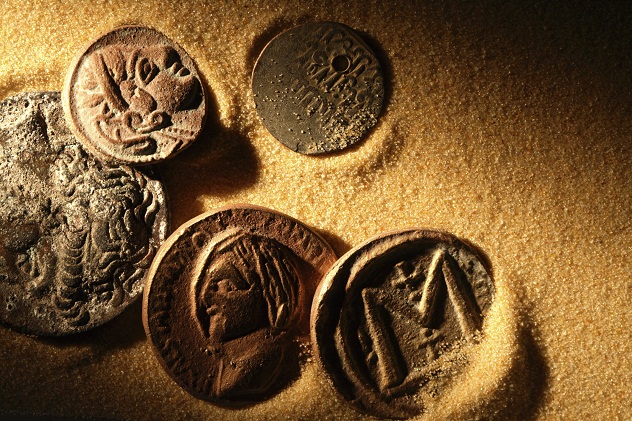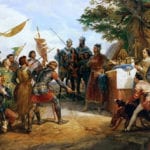 Mysteries
Mysteries  Mysteries
Mysteries  History
History 10 Surprising Stories About the Texas Rangers
 Humans
Humans 10 Philosophers Who Were Driven Mad by Their Own Theories
 Miscellaneous
Miscellaneous 10 Video-Game-Worthy Weapons and Armors from History
 Weird Stuff
Weird Stuff 10 Psychics Who Accurately Predicted Wartime Events
 The Arts
The Arts 10 Pieces of Art Inspired by a Broken Heart
 Health
Health 10 Science Fiction-Sounding New Medical Treatments
 History
History 10 Surprising Facts About the Father of Submarine Warfare
 Space
Space Ten Astonishing New Insights into Alien Worlds
 Weird Stuff
Weird Stuff 10 Bizarre Summer Solstice Rituals Still Practiced Today
 Mysteries
Mysteries Top 10 Haunting Facts About the Ghost Ship MV Alta
 History
History 10 Surprising Stories About the Texas Rangers
 Humans
Humans 10 Philosophers Who Were Driven Mad by Their Own Theories
Who's Behind Listverse?

Jamie Frater
Head Editor
Jamie founded Listverse due to an insatiable desire to share fascinating, obscure, and bizarre facts. He has been a guest speaker on numerous national radio and television stations and is a five time published author.
More About Us Miscellaneous
Miscellaneous 10 Video-Game-Worthy Weapons and Armors from History
 Weird Stuff
Weird Stuff 10 Psychics Who Accurately Predicted Wartime Events
 The Arts
The Arts 10 Pieces of Art Inspired by a Broken Heart
 Health
Health 10 Science Fiction-Sounding New Medical Treatments
 History
History 10 Surprising Facts About the Father of Submarine Warfare
 Space
Space Ten Astonishing New Insights into Alien Worlds
 Weird Stuff
Weird Stuff 10 Bizarre Summer Solstice Rituals Still Practiced Today
10 Awesome Facts About The Celts
The Celts are a misunderstood bunch, shrouded in mystery, intrigue, and (unfortunately) lies. There are plenty of misconceptions and false truths about them, but we’re going to clear up a few.
10 Origins

Frankly, nobody really knows where they came from. (Sorry!) Some historians claim that there were Celts in Britain about 1180 B.C., while others argue that it was earlier. However, it is generally accepted that the Celts started to migrate from Central Europe in 400 B.C. They spread in all directions, that is, until they came face to face with the Romans.
The problem was that their Roman neighbors were a single, unified empire, while the Celts were made up of dozens of tribes, who fought against each other as often as they joined together to fight the Romans. Eventually, some of these tribes were completely wiped out, some agreed to be ruled by the Romans, while others were driven to the far corners of the known world such as Ireland, Scotland, and Wales. (These communities of modern Celts are still around today, and strive to preserve Celtic culture via The Celtic League.) Some of these travelling Celts even ended up way as far away as Egypt and Greece.
9 They Didn’t Fight Naked

Mention the Celts to anyone and they’ll probably tell you something along the lines of “Oh, were those the guys that fought naked with a gold band (called a torc) around their neck?” Sigh.
After performing the necessary number of facepalms, you should enlighten them with the truth. This is one of the biggest misconceptions about the Celts, which is absolutely ridiculous if you put some thought to it. (Even Mel Gibson wasn’t fooled by this one—come on, guys.) So who do we have to blame for spreading this false truth? Well, you can thank the Romans for that. Since almost all of the evidence that we have on the Celts is in the form of accounts by Roman historians, it’s practically safe to assume that the Romans were exaggerating a bit. You see, when all records of you were written by your enemy, you can guarantee that your enemy will make themselves look good, while you end up being described as a simple-minded savage. This is exactly what happened to the Celts, since let’s face it, history is written by the victor (Would you trust your worst enemy to write the only records of your existence?).
One could also look at this from another angle; the Celts lived during a period known as the Iron Age. This was a time when iron was used instead of bronze, to craft weapons, armor, and tools. The Celts had access to a variety of weapons such as swords, axes, javelins, and two-handed hammers, as well as leather padding, metal plates, and chain mail to use as armor. Knowing this, fighting naked seems a bit daft and unlikely.
8 Druids

Celtic Druids were like the badasses of their day. Aside from running around in long white robes and offering human sacrifices, they did some pretty neat stuff as well. They advised the chiefs and kings to enact new laws (kind of like how the British government advises the Queen today—sure they’re her laws, but everyone knows that the government runs the country), and they even acted as judges to enforce their own laws. Druids were considered to be the wisest of the bunch because they spent 20 years in training for their positions. Their knowledge ranged from astronomy and Celtic lore to natural philosophy. Since they were the wisest men around, the Druids would often advise villagers on when to plant their crops, and even predicted their futures (or so they believed).
Additionally, the Celtic Druids gave us a tradition that is still with us to this very day. Druids considered the oak tree to be very holy, since they believed that their gods were everywhere—in streams, rocks, trees—anywhere, really. According to the Druids, the only thing holier and more magical than the oak was the mistletoe that grew on it. Today, people still believe this and that’s why we have the Christmas tradition of kissing under the mistletoe. So next time you’re awkwardly standing alone under the mistletoe during Christmas, blame the Druids.
7 Celtic Women

Since the Romans wanted us the believe that the Celts were a bunch of uncivilized savages, one would assume that life must have been pretty grim for Celtic women, right? Women could have power, own land, and even divorce in Celtic society, which was unheard of in the classical world. (Unlike their Roman counterparts, Celtic women could also climb up the social ladder, either by inheriting status, or by achieving it.) Landowners were expected to fight if their chief went to war, and if the landowner happened to be a woman, then she was expected to fight as well. In fact, women warriors could teach young girls and boys how to fight.
They could even become Druids, who wrote laws that safeguarded all of Celtic society, including the elderly, disabled, and children. What’s really interesting about the latter is that children were protected under Celtic law because of their innocence. This is quite a contrast to the Roman world, in which unwanted children were abandoned and left to die in rubbish dumps. Turns out the Celts weren’t as bad as the Romans wanted us to believe after all.
6 They Built Excellent Roads

Roman engineers are usually credited to be the first to build a reliable network of roads that connected all of Europe together. After all, it’s a historical fact, right? Wrong again! Contrary to popular belief, the Celts actually had a pre-Roman network of wooden roads that connected the settlements of various Celtic tribes so that they could engage in trade. The problem with wooden roads is that, due to their nature, very little evidence remains of them since most of them have rotted away. However, a few planks have been discovered to be preserved in bogs in Ireland, England and France. Since the Romans never actually conquered Ireland, we can safely say that these old planks were actually part of a Celtic road system. Additionally, one can view more information about Celtic roads by learning about Corlea Trackway, situated in Ireland. Here, many parts of an old road were recovered, and a section of the road has been reconstructed to give an idea of how it might have looked like back in its golden days.
5 Weird Helmets

Now that you know that the Celts had actual metal armor and chain mail, you’d probably guess that they had some pretty sweet helmets to go with their armor as well. And you’d be right. In fact, the Celts had a bunch of really crazy helmet designs, one of which was discovered in Ciumesti, Romania (remember, the Celts were widespread across all of Europe). Here, an old Iron Age cemetery was discovered, in which 34 graves in total were excavated. Turns out these graves belonged to a rich Celtic chieftain, who was buried there along with many objects such as bronze weapons and armor (supposedly to aid him in the afterlife). Among these objects a rather odd helmet was found—it consisted of a large bird of prey perched on top, with its bronze wings spread out for all to see.
What’s really cool about this helmet is that the wings were also hinged, which meant that they could flap up and down. Historians believe that the chieftain would only wear the helmet on special occasions, as a flapping helmet would prove to be quite an annoyance in battle. This helmet ended up being one of the most known and reproduced pieces of Celtic art. One only needs to look at a picture of Asterix and Obelix to see the resemblance.
4 They Loved A Fight

On top of their far-reaching travels, the Celts loved a fight and would fight for anyone—at a price. Celtic mercenaries were famed for their reputation in combat, and they were known to have been recruited by Ptolemy II, king of Ptolemaic Egypt. The mercenaries were so good that the king feared that they might take over Egypt for themselves, so he had them marooned on a deserted island in the Nile.
The Greeks also met the Celts, who at the time were expanding their territories. This is known as the Gallic Invasion of the Balkans, and the Battle of Delphi was the highlight of this invasion, which resulted in a Celtic defeat. Here, the Greeks were organized and fought together as a team, so they could easily defeat the disorganized Celts, who fought as individuals. Thus, the Celts ended up being pushed out of Delphi in 279 B.C.
3 Headhunting

If I had to choose one thing the Celts are most famous for, it would probably be the fact that they were headhunters. They believed that the greatest prize in battle was their enemy’s head. This could come from the fact that the Celts had a religion similar to animism, in which they believed that spirits and gods resided in streams, rocks, trees, mistletoe—you get the idea. The human head was no exception, as they believed that a person’s soul lived inside their heads.
To the Celts, having a collection of heads was a sign of great honor and prestige, plus it gave them bragging rights. Thus, they would even go as far as to decorating their saddles and the doors of their houses with the severed heads of their enemies. For a comparison, it’s kind of like owning a lot of expensive cars. We would brag about owning a rare Ferrari or something of the sort, while the Celts would brag about owning the severed head of a very powerful enemy leader.
2 They Were Extremely Rich

Here’s a little back story: The year is 58 B.C., and the Romans and Celts are all living peacefully in their respective territories. Now imagine you’re Julius Caesar. Your political career is mediocre so far, you have large amounts of debt, and you need to really prove that you are somebody. What would you do? Why of course, invade the “simple and barbaric” Celts—surely they wouldn’t mind.
The Gallic Wars are often regarded as Julius Caesar’s greatest military victory. This was the beginning of the rapid expansion of the Roman empire, in which Caesar systematically defeated several Celtic tribes to gain control over the area. This Roman victory would decide the fate of the area known as Gaul (modern-day France), which was ruled by several Gallic tribes. This resulted in Caesar earning plenty of glory and praise for his military triumphs. But why did he exactly invade Gaul? According to Caesar himself, he was just pushing back the invading barbaric tribes, but now, historians have learned otherwise.
One of these invading tribes were the Helvetii, which were initially located near the Alps. This tribe were planning to migrate to France under the protection of Caesar, but when he refused, they decided to pass through Gallic territory. Caesar then stated that Rome had to protect the Celts that were already in France, which he “protected” by massacring more than a quarter of a million people of the invading tribes. He continued “protecting” these tribes until they were eventually all wiped out. Gaul ended up falling to the Romans.
What does this have anything to do with the Celts being rich? Simple: First and foremost, Caesar was a politician. He desperately needed cash to pay his debts, and he needed a military conquest to boost his political career. Celtic Gaul would provide him with both, as he knew that the area was rich in gold deposits. Although it was known that the Celts had gold coins and jewelery, up until recently it was only believed that they had acquired them through trade. Turns out that in Gaul alone, there were over 400 Celtic gold mines. Thus, the Celts were extremely wealthy-no wonder why Caesar wanted to get his hands on their mines. Funnily enough, the Romans started to mint their own gold coins after the conquest of Gaul.
1 They Weren’t Simpletons
By now, most of you should have picked up on the fact that the Romans would make you look bad, especially if you were their enemy. So far, we have learned that the Celts weren’t as bad as the Romans made them out to be (with the possible exception of the whole headhunting thing). However, the Celts may have had one thing which was vastly superior over the Romans: a calendar.
Sure the Romans had the Julian calendar, but the Celts had what is known as a Coligny calendar. It was found in Coligny, France (hence the name) back in 1897. Apart from looking awesome, the calendar is made up of a number of mysterious metal pieces decorated with intricate markings, such as lines, holes, numbers, and a couple of Greek, Roman, and Celtic letters. Apart from knowing that it was some kind of calendar, scholars were baffled for over a century. However, in 1989, the calendar was finally deciphered. It was found to be a lunar-solar calendar, which calculated the time of year based on the cycles of the sun and moon. This very accurate calendar was way ahead of its time, as it could accurately predict the position of the sun at any given month in the future. In the above video, the professor who cracked the calendar’s mystery attempts to explain the system (just after the 12-minute mark). You have been warned though, as in the words of the confused presenter, “Calendars are terribly complicated things.”
Perhaps more importantly, this calendar is living proof that the Celts were capable of mathematical and scientific thought. Just to show how accurate this thing was, let’s compare it to the Roman calendar. The contemporary Roman calendar was also considered to be quite accurate for its day, since it erred from the real solar calendar by only 11.5 minutes a year. However, after centuries have passed, even a small inaccuracy adds up over time. The Coligny calendar was so advanced compared to its Roman counterpart that the Romans would be celebrating the beginning of spring in the middle of August, while the Celts’ version still remained true to the real solar calendar. Take that, Romans.
I’ve been a long time reader of Listverse, and now I’ve decided to take the plunge and start writing my own lists. You can email me comments and suggestions.








